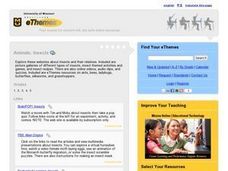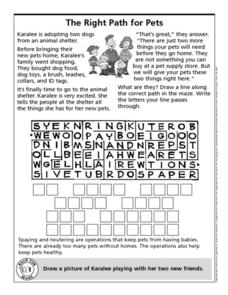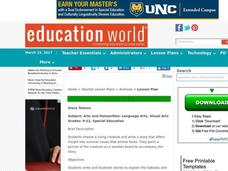Curated OER
Environment: Assess Your Habitat's Health
Students research their ecozone in Canada and label on maps various parks and wildlife areas. They role-play as doctors with their ecozones as patients and search for symptoms from pollution, urbanization, loss of habitat, and decline of...
Curated OER
Animals: Insects
Students use the Internet to examine insects and their relatives. They participate in online games and discover insect recipes.
Curated OER
Animals: Panda Bears
Students discover the difference between giant and red panda bears. They examine their habitat, food, and why they are endangered.
Curated OER
Marine & Aquatic Habitats Activities - Walk in the Wetlands
Students research various types of fresh water wetlands and identify the common animal and plant life in these different ecosystems. They further analyze the need to protect these wetlands and explore their varied uses.
Curated OER
A Habitat Is Home
Students are introduced to the concept and components of a habitat. They discuss the key components of a habitat and describe how certain factors can cause disturbances in a habitat and change its population. Activities are leveled...
Curated OER
The Right Path for Pets
In this animal care worksheet, young scholars learn the important steps to take before adopting a dog from an animal shelter. Students follow a maze of letters which eventually tell them about spay/neutering for pets.
Curated OER
Populations: Food Web
In this populations worksheet, students analyze the food web given and answer three questions. Then they draw a food web and predict populations changes.
Curated OER
Where Do Animals Live?
Students c;assify where pets live and where wild animals live and comprehend the differences. They investigate what kinds of homes pets and wild animals need. Students bring in a stuffed animal or puppet from home and match their...
Curated OER
The Mixed-Up Chameleon
In this animal environment worksheet, students draw a color a chameleon and his surroundings. Students then write three things he must do to stay alive.
K12 Reader
Habitat Destruction
What happens when an animal becomes endangered or extinct? Explore the ways that human influence throughout the environment has threatened the existence of other species with a reading passage. After reading the paragraphs, kids answer...
American Museum of Natural History
Cuban Wildlife Matching Game
Young biologists match Cuban wildlife to their ecosystems by dragging images of the creatures to either a forest, coral reef, cave, or wetland habitat.
Curated OER
Let's go to the Video Tape!
Using actual data from a deep-sea video survey, high school marine biologists consider the biodiversity, compare species richness between two communities, and learn to calculate the diversity index. The lesson plan is all-inclusive,...
Prince William Network
The Incredible Journey
Divide your school gym into breeding grounds and non-breeding grounds so that your zoologists can play a game simulating the seasonal migration of shorebirds. Players pick one of the included game cards and follow its directions, which...
American Museum of Natural History
The Legend of the Flying Frog
Young conservation biologists have an opportunity to get involved in the effort to save endangered species. After reading and illustrating the tale of the Flying Frog, they craft a tale about another fictional endangered species.
Curated OER
Story Totems
High schoolers write and illustrate a story to describe the habitat and life cycle of a selected animal. They write and publish their story, and create a picture of the animal on a wooden board.
Curated OER
Oh Deer!"
Students explore the essential components of a habitat, which is food, water, and shelter. They end the lesson plan by paying the Oh Deer! game.
American Museum of Natural History
Bio-Benefits
Kick-start a discussion of the importance of biodiversity with a colorful resource that touts the benefits of maintaining healthy ecosystems. The images stress the interdependence of all the elements of an ecosystem.
Conserve Wildlife Foundation of New Jersey
The Great Peregrine Scavenger Hunt - On the Internet
The story of one bird provides valuable insight into general animal behaviors and interactions. Young researchers investigate the peregrine falcon using a web search. They analyze the behaviors of the raptor including its migration...
Curated OER
What Do Koalas Need to Survive?
First graders take a field trip and examine the Koala and his habitat. In this Koala lesson, 1st graders read Possum Magic and discuss the foods of Australia. Students view the habitat of a Koala and record what it eats, its physical...
American Museum of Natural History
Going, Going...Gone?
Young environmentalists consider how scientists are attempting to save endangered species. They read about what causes extinction and steps to take to minimize the threats.
American Museum of Natural History
They Glow!
Let there be light! An interactive online lesson describes the process of bioluminescence and how ocean species use it to their advantage. The lesson highlights several specific species as well as provides vocabulary support with...
Curated OER
Wild Where?
Young scholars investigate why the urban environment is considered a hostile environment; define the concept of endangered species; describe and identify a Peregrine Falcon; describe and identify the eating habits of the Peregrine Falcon.
Howard Hughes Medical Institute
Seed Dispersal in Tropical Forests
How do seeds get around? It's not like plants can control seed dispersal—or can they? Dig deeper into the amazing mechanisms of seed dispersal observed in tropical plants through interactives, a video, and plenty of hands-on data...
Howard Hughes Medical Institute
Scientific Inquiry Using WildCam Gorongosa
How do scientists determine what questions to ask to meet their research goals? Help your class develop an inquiry mindset with a lesson based on studies in the Gorongosa National Park. Partners create their own research questions by...
Other popular searches
- Zoo Animals Habitats
- Matching Habitats With Animals
- Swamp Animals Habitats
- Pet Animals Habitats
- Educational Animals Habitats
- Farm Animals Habitats
- Forest Animals Habitats
- Matching Animals and Habitats
- Habitats Animals Captions
- Water Animals Habitats
- Desert Animals Habitats
- Habitats Animals and Plants

























